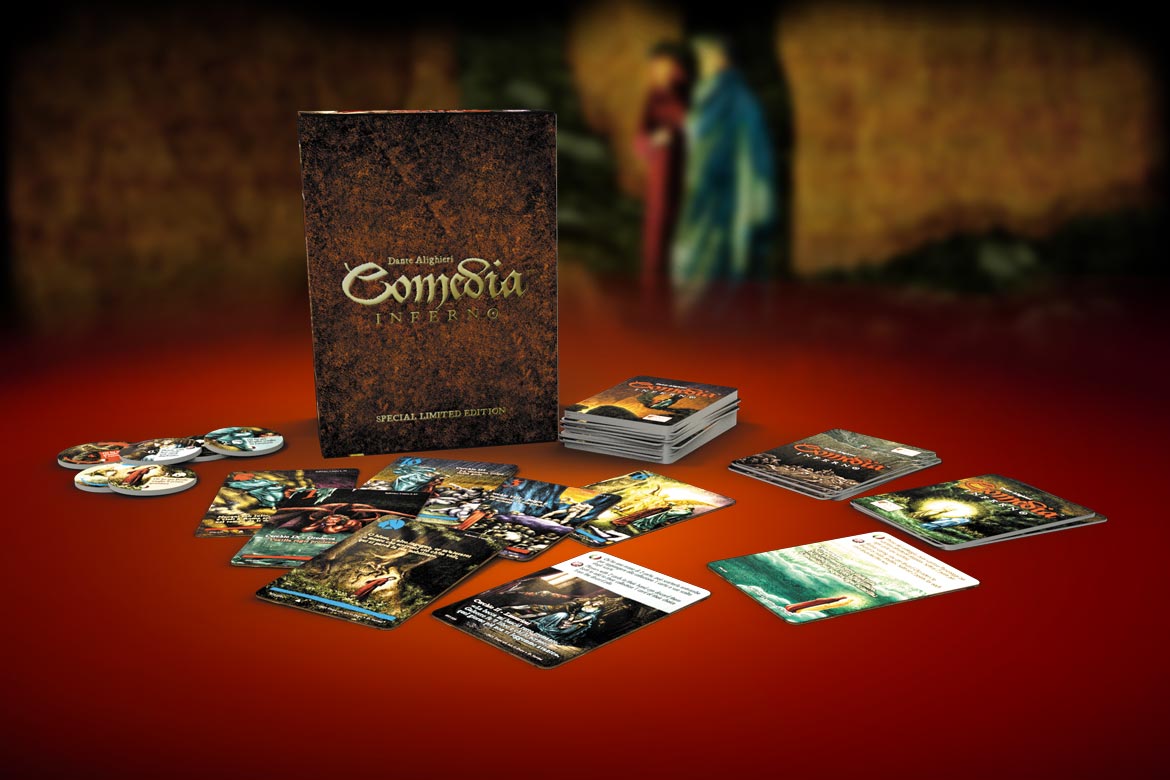How to play the Comedia
How do you play Dante Alighieri: Comedia - Inferno? This is one of the most frequent questions sent in by our followers. Let's start with a concept that is fundamental for us: this game is not just a glorified gadget thrown together for Dante’s national celebrations. It was really born as a Dante-themed game long before becoming Dante 2021’s official game.
The game designed by Federico Latini and produced by Sir Chester Cobblepot is based on an original spiral draft mechanic which earned this project the 2015 Nerd Play Award contest promoted by Lega Nerd and Cobblepot at Modena Play, the biggest gaming festival in Italy. In the following years of development, we have perfected the rules and made the fascinating literary theme adhere perfectly to the game mechanics.
The "base" game has 90 cards divided into two colors, red and blue, containing 66 Encounters and 24 Characters. Encounter cards represent what Dante and Virgil faced on their journey through the Circles of Hell. These cards numbered from one to eleven with a catch: there are copies of each card equal to its value (only one copy of the 1-valued card, while there are eleven 11-valued cards, etc.).
All cards of this type follow the same rule. The winning strategy is to collect them in a single copy, in order to score them at the end of the game. Duplicates will invalidate this condition and every card with the same number will be worthless. You will understand that it is easy to collect the 1-valued card, since it does not have duplicates, while it is complex to limit yourself to having only one 11 card.
Characters are, on the other hand, support cards: Dante, Virgil and the Guardians are useful to the players during the game. However, not only are they not worth any points at the end of the game, they might also lead you to defeat if you are involved in a tie. Cards of this type also fit into the draft mechanic, so each player must make pondered choices, for himself and on behalf of the opponents.
Game rounds also revolve around six tokens which introduce other rules and make the system work wonderfully. These components, assigned during setup, will be passed around by players according to certain conditions at the start of each round, creating a continuous tactical attention that never decreases the players’ involvement while remaining simple and linear.
Dante is, of course, the first token: whoever has it, is the dealer and chooses who will be the first player of the round to be played. If, among those who are reading us, there is someone who does not understand how important this "power" is, they will discover it by playing. How do you get it? You must have the most Dante cards in your collection.
Virgil is the second token. The "guide" chooses the direction of rotation, clockwise or counterclockwise, of the round in progress: the player chosen by Dante plays first, but Virgil decides which side to "descend" into Hell. Appropriate, isn't it? To be able to exercise this "power", you need to have the largest number of Virgil cards in your collection, following the same logic.
The third token is that of the She-Wolf, the first of the three beasts that Dante crosses before entering Hell: if you have followed us closely up to here, you will have guessed that this token will be given to those with the most She-Wolf cards in their collection. That player will be called upon to resolve any ties occuring during the round.
The fourth token features the Lion, the second beast, and it is given to whoever has more red cards: whoever controls it, when receiving the token, has the opportunity to discard a red card from their collection or to draw a red card from the discard pile. A nice way to adjust your collection by enriching it or "purging” it of waste.
The penultimate token is that of the Leopard, the third beast. Same thing as the Lion but applied to the blue cards: whoever has the most blue cards controls it and, when they receive that token, they have the opportunity to discard a blue card from their collection or to draw a blue card from the discard pile. During the game, the color of the cards (both Encounters and Characters) is irrelevant, but not for the strategic importance that these tokens have.
The last token is dedicated to two eminent characters of the Comedy: Paolo and Francesca. The two lovers are given to the player who has fewer cards in their collection granting them the opportunity, when they receive it, to steal one card from each opponent, as long as they are duplicates for the latter. Each effect is perfectly calibrated, themed and leads to a mathematical balance in which players’ strategy makes a difference.
We kept the most interesting explanation for the grand finale: do you remember that we mentioned a "spiral draft"? When the dealer deals cards for the current round, they give the first player as many cards as the number of players plus one; every other player gets one less until the last one has only two. Each turn, you must choose a card and pass all the others, except for the last player who must discard the card they did not choose each turn.
A card-drafting game with an asymmetrical number of cards in each hand?? You may be wondering how all this can be balanced, since each card can be worth points, but follow this reasoning: is it better to have many cards in hand but play only one, or to play more cards while risking that your opponents pass you duplicates? If there was only one right choice, Cobblepot would not have produced this little gem. All you have to do is secure a copy for April 2021 and play it.

